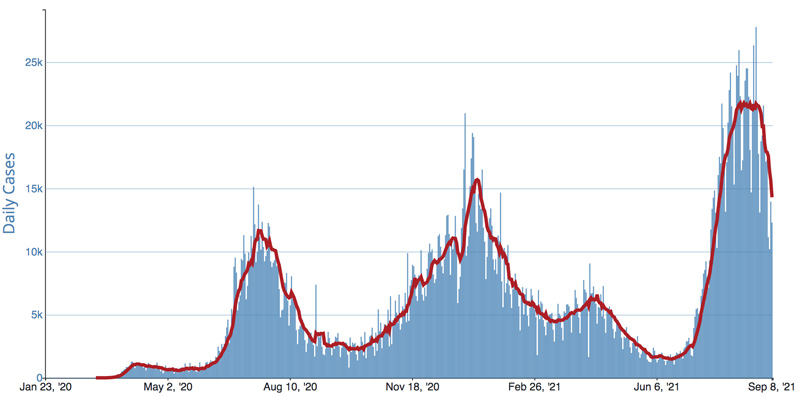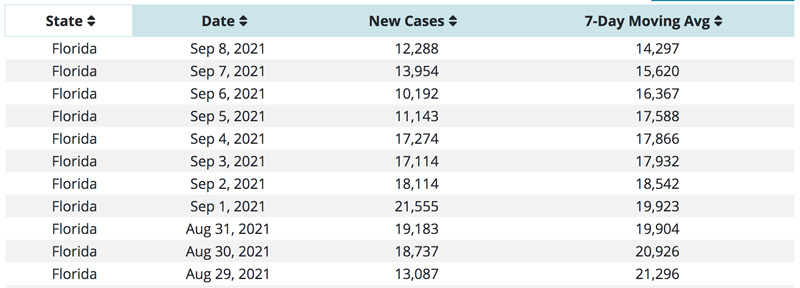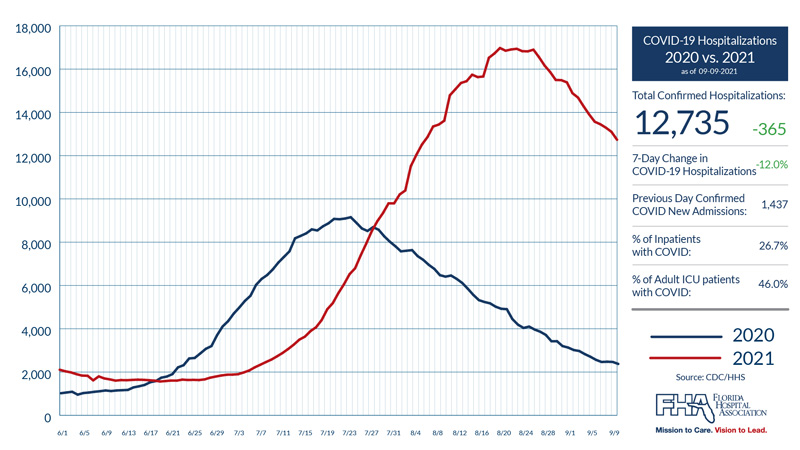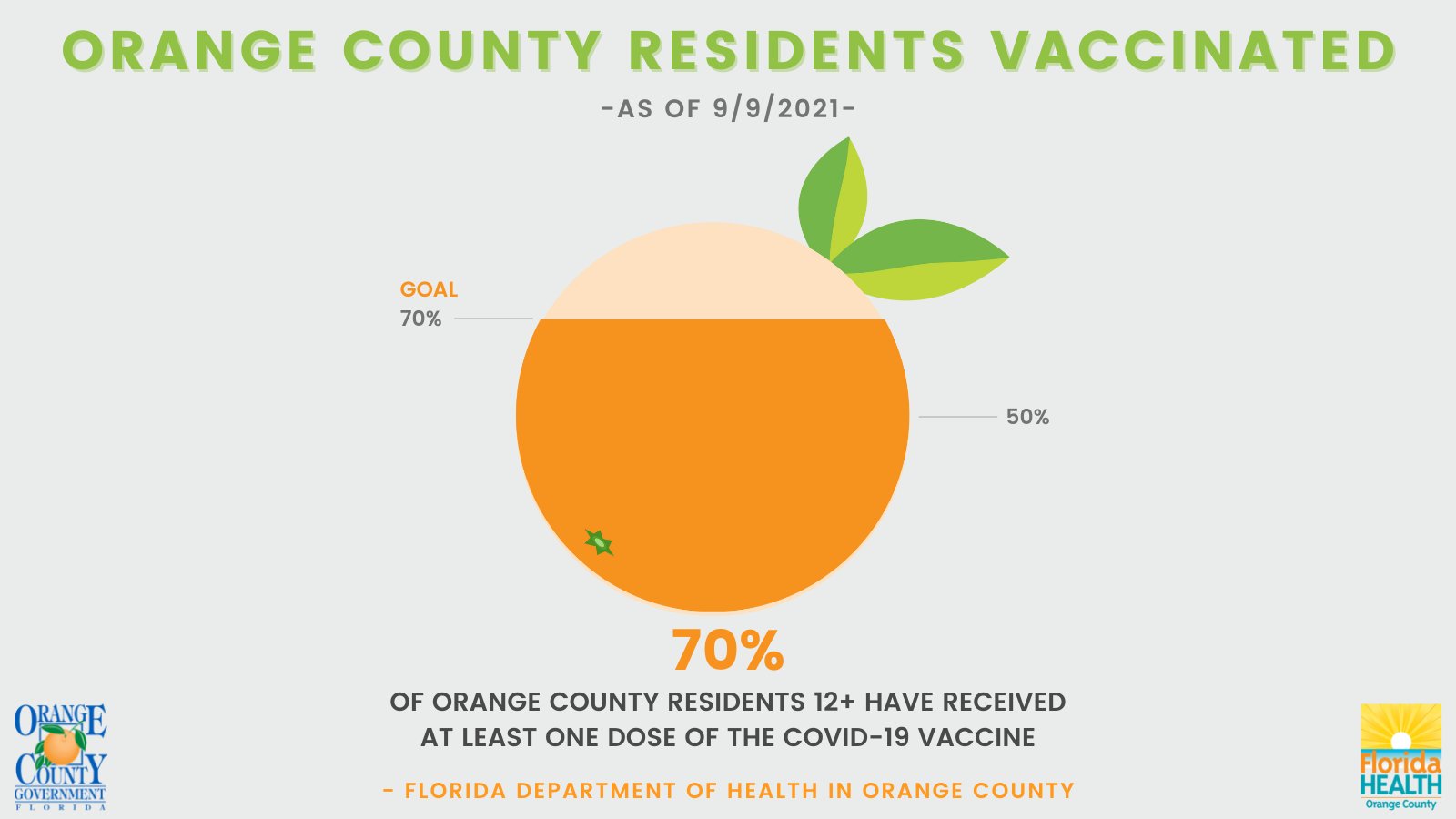Florida’s COVID Cases Falling Fast
We’re back with another installment of the weekly COVID-19 report with data from Florida and around Walt Disney World as of September 9, 2021. This provides an update on new cases, positivity, hospitalizations, plus commentary from Orange County’s weekly health briefing.
Our update this week is delayed by several days due to the Labor Day. We deliberately held off a bit longer than normal for a couple of reasons. First, because numbers from holiday weekends are often artificially low due to reduced testing and delays in data reporting. Trends from late last week through early this week were incredibly promising, but we still didn’t want to be premature with the good news.
Second, because Orange County didn’t hold its weekly health briefing until today, and that press conference is often useful for contextualizing the data and providing other relevant information for the communities around Walt Disney World. Although the report is a few days late, it should offer better clarity about Florida’s current trends and reinforce the optimistic numbers…
We’ll start with numbers from the CDC, which reported 12,288 new cases in Florida for September 8, 2021 (the most recent date for which there’s data). Additionally, Florida’s 7-day average of new cases currently stands at 14,297.
This is a drop of 11% from the day before, with the rolling average of cases declining 29% from a week earlier, per CDC data. Here’s how that looks in graph form:
As of last week’s COVID-19 report, Florida’s 7-day moving average had decreased to 21,288 (that number was subsequently revised downward to 20,926). At that time, Florida’s 7-day moving average of new cases had been in the 21,000s every day since August 10, 2021.
Here’s a daily case log showing how that plateau became a clear and sharp drop last week:
Even several days removed from the holiday weekend when testing locations would’ve had reduced operating hours, Florida is still seeing a drop in new cases.
It would thus appear there is no backlog, and barring the holiday weekend causing an uptick in cases, it appears Florida will continue trending downward at a quick pace. This is further corroborated by a dropping positivity rate and the fact that Florida did not see a post-Labor Day spike last year. To the contrary, cases continued dropping and bottomed out during the first week of October. The current trajectory of cases and positivity numbers are setting the table for a redux of that in early October 2021.
Normally, hospitalizations lag cases. However, the Florida Hospital Association is reporting a decline in new hospitalizations. The total number of hospitalizations as of today is 12,735.
This number is down 12% week-over-week, when it had already started to decrease ahead of new cases. As of our last report over a week ago, the daily number was 15,488–which was down 9.5% at the time.
Per numbers from the Department of Health and Human Services, coronavirus patients accounted for 22% of Florida’s inpatient beds and 46% of ICU beds. In total, 83% of hospital beds in Florida are in use.
Again, these numbers are down week over week. This is more good news, particularly for anyone who was apprehensive about visiting Florida in the coming weeks due to hospital resources.
In fact, AdventHealth Central Florida moved from red to yellow status today, having moved from black to red status last week. As a result, surgeries and more routine procedures can resume, as the hospital is now at only 75-80% of normal operational activity, according to a hospital rep interviewed by the Orlando Sentinel.
AdventHealth reports just over 1,100 patients currently, which is a decrease of approximately 600 from its record on August 23, 2021. COVID-19 patients in the ICU at AdventHealth have also dropped by ~25% to 30%. Approximately 92% of AdventHealth’s COVID-19 patients are unvaccinated.
Circumstances are similar at Orlando Health, which has under 600 COVID-19 patients. This is down from the hospital system’s peak in late August when it had nearly 900 COVID-19 patients. As with AdventHealth, over 90% of their hospitalized patients are unvaccinated.
This has eased the burden on resources to allow for the resumption of outpatient surgeries. New surgical procedures are still reduced, elective surgeries that require inpatient admissions are deferred, and elective surgeries that require an ICU bed must be approved.
The latest weekly situation report from the Florida Department of Health is a bit stale at this point, having been released on September 3. With that in mind, it shows a marked decrease in new cases, with only 129,240–as compared to over 150,000 in each of the prior 3 weeks.
Additionally and perhaps more notably, rolling positivity is down to 15.2%, as compared to 17.1% the week before that (and over 20% the week before that). This is the lowest Florida’s rolling positivity rate has been since mid-July, just before the current wave started getting bad.
This report shows new cases dropping in the last the week among every age range (including those under 19 years old), with the highest case numbers occurring in age ranges among those under 39 years old. The statistical likelihood of being hospitalized decreases along with age.
Again, over 80% of residents above the age of 60 are vaccinated, whereas less than half of those under age 30 are fully vaccinated. Weekly numbers continue to reflect an accelerated rate of vaccination among younger age cohorts.
As of today, Florida now ranks 9th in the United States for average daily COVID cases per capita per data from the New York Times. That’s still high, but given that Florida accounted for nearly 25% of all cases in the nation only a few weeks ago, it’s a sharp drop.
All of these numbers are certainly cause for optimism, and there’s every reason to believe the current trends will continue. With that said, Florida is now hitting record numbers of daily deaths, exceeding the previous highs from January.
Just today, Florida reported a new ‘batch’ of 1,296 deaths attributed to COVID-19. Deaths are now retroactively added to the date on which they occurred–not the day they are reported–and can take up to two weeks to be reflected in the CDC data. Consequently, the current 7-day average is low and doesn’t yet reflect where deaths will be once reported. (Current deaths are in the range of 200-300 per day, a number that will likely remain elevated for at least the next week.)
This methodology change has been “controversial,” as some critics argue that it obfuscates current trends. We do not agree with that position–and would note that several other states take the same approach. Moreover, anyone following these numbers knows deaths lag cases; one can surmise the trajectory of the pandemic based upon cases and positivity.
This afternoon, Orange County Mayor Jerry Demings and other local health and tourism leaders held their latest press conference, which you can view for yourself above. (As with the last few weeks, this one is not really worth watching.)
At the outset, Mayor Demings indicated it was a mix of good and bad news–falling cases and positivity numbers amidst rising deaths, mirroring Florida’s statewide numbers.
Dr. Raul Pino from the Florida Department of Health in Orange County also spoke at the press conference, indicating that “the pandemic is improving in our county” per the data. These numbers included that the 7-day positivity average for Orange County is now down to 14.32% (from 16.1% in our last report).
He also confirmed that 70% of eligible Orange County residents have received a COVID-19 vaccine. Earlier in the week, Orange County officials reported that the vaccination rate was ~68%, so the daily number of inoculations continues at a brisk pace.
Following the ‘good’ portion of his briefing, Dr. Pino turned to rising deaths and said: “we are now facing the consequences of the high wave we had a couple of weeks ago. We knew these numbers would be significant due to the number of cases that were hospitalized…cases in ICU will end up having high mortality rates.”
“The reality is that there are a number of people who are unvaccinated and the large majority of the deaths are among unvaccinated people. These vaccines are very good at protecting against illnesses and death. That, unfortunately, was ignored,” said Dr. Pino during the Q&A. “This pandemic, at least this wave, was mostly among unvaccinated people.”
While the declining positivity rate is good to see, it’s worth noting that the CDC’s criteria for moving down to the moderate level where face masks are no longer recommended indoors is under 50 total new cases per 100,000 persons in the past 7 days and under 8% test positivity during the past 7 days. (No update was provided on Orange County’s cases per 100k persons this week, but it was over 500 last week.)
Orange County’s numbers are heading in the right direction, but are still very high as compared to CDC targets and where they were earlier this summer. It’s probably going to be until at least October before another change to Walt Disney World’s face mask rules.
Due to the holiday weekend, we don’t have any commentary from Dr. Scott Gottlieb on CBS Face the Nation Sunday. His Twitter feed lately has been largely focused on routine testing in schools to preserve in-person learning. That’s beyond the scope of this post, but might be of interest to parents.
For lack of anything else to share, we’ll once again end by reiterating that population immunity, both from natural infections and vaccinations, will dramatically decrease severe outcomes in any future waves or flare ups that may emerge next year or beyond as COVID-19 becomes endemic.
This recent piece in The Atlantic (which we highly recommend reading) discusses the need for Americans to recalibrate their expectations, as preventing all infections or eliminating the coronavirus is not a realistic goal. However, widespread vaccinations could turn COVID-19 into something more like influenza, with the key message that if you’re vaccinated, you’re well protected against life-threatening disease. In life, there is no such thing as eliminating risk–only mitigating it.
Planning a Walt Disney World trip? Learn about hotels on our Walt Disney World Hotels Reviews page. For where to eat, read our Walt Disney World Restaurant Reviews. To save money on tickets or determine which type to buy, read our Tips for Saving Money on Walt Disney World Tickets post. Our What to Pack for Disney Trips post takes a unique look at clever items to take. For what to do and when to do it, our Walt Disney World Ride Guides will help. For comprehensive advice, the best place to start is our Walt Disney World Trip Planning Guide for everything you need to know!













